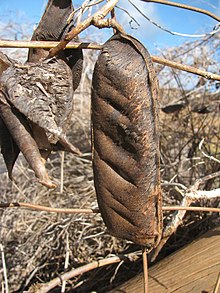Canavalia cathartica
| Canavalia cathartica | |
|---|---|
 |
|
| Scientific classification | |
| Kingdom: | Plantae |
| (unranked): | Angiosperms |
| (unranked): | Eudicots |
| (unranked): | Rosids |
| Order: | Fabales |
| Family: | Fabaceae |
| Subfamily: | Faboideae |
| Tribe: | Phaseoleae |
| Genus: | Canavalia |
| Species: | C. cathartica |
| Binomial name | |
|
Canavalia cathartica Thouars |
|
| Synonyms | |
|
Canavalia glandifolia |
|
Canavalia glandifolia
Canavalia microcarpa
Canavalia polystachya
Canavalia turgida
Canavalia virosa
Dolichos virosus
Lablab microcarpus
Phaseolus virosus
Canavalia cathartica, commonly known as maunaloa, is a species of flowering plant in the legume family, Fabaceae. It has a Paleotropical distribution, occurring throughout tropical regions in Asia, Africa, Australia, and many Pacific Islands, and extending just into subtropical areas.
This plant is a biennial or perennial herb with thick, twining, climbing stems. The pinnate leaves are each divided into three papery leaflets which are generally oval in shape with pointed or rounded tips. They are up to 20 centimeters long by 14 wide, but usually smaller. The inflorescence is a raceme or pseudoraceme of several flowers. The flower has a bell-shaped calyx of sepals with two lips, an upper lip with two lobes and a lower lip with three teeth. The flower corolla is pink or purplish with a white-spotted standard petal and two wing and two keel petals each roughly 3 centimeters long. The fruit is an inflated, turgid legume pod up to 13.5 centimeters long by 4.5 wide. The fresh, mature pod can weigh over 32 grams. The hard, smooth seeds are reddish brown, darkening deeper brown, and reaching nearly 2 centimeters long by one wide.
In India this plant grows in mangroves. The seeds float on the water and land on coastal sand dunes, where the plant establishes. It is mat-forming and binds the sand, preventing erosion.
This legume has a rich microbial ecology, including its nodal rhizobia, its arbuscular mycorrhizae, and an assemblage of endophytic fungi. Common arbuscular fungal associates include the glomeromycetes Gigaspora albida, Acaulospora spinosa, and several species of Glomus, including G. aggregatum. Microbial surveys have catalogued many endophytes in the plant, with varying assemblages in different habitat types. It houses the ascomycete Chaetomium globosum in its roots. It also contains Colletotrichum dematium,Aspergillus niger, A. flavus, Fusarium oxysporum, and Penicillium chrysogenum. The microbial life hosted by the plant likely helps it persist in harsh coastal habitat.
...
Wikipedia
